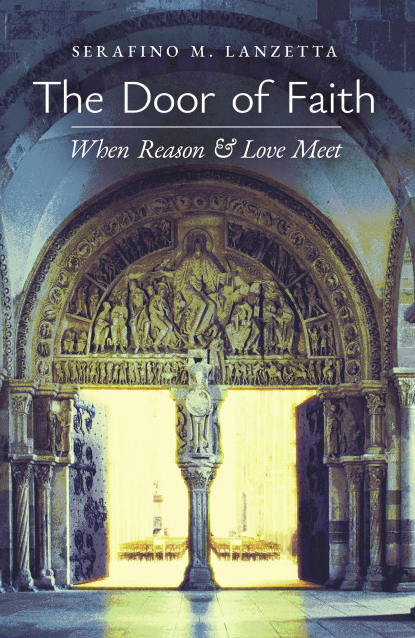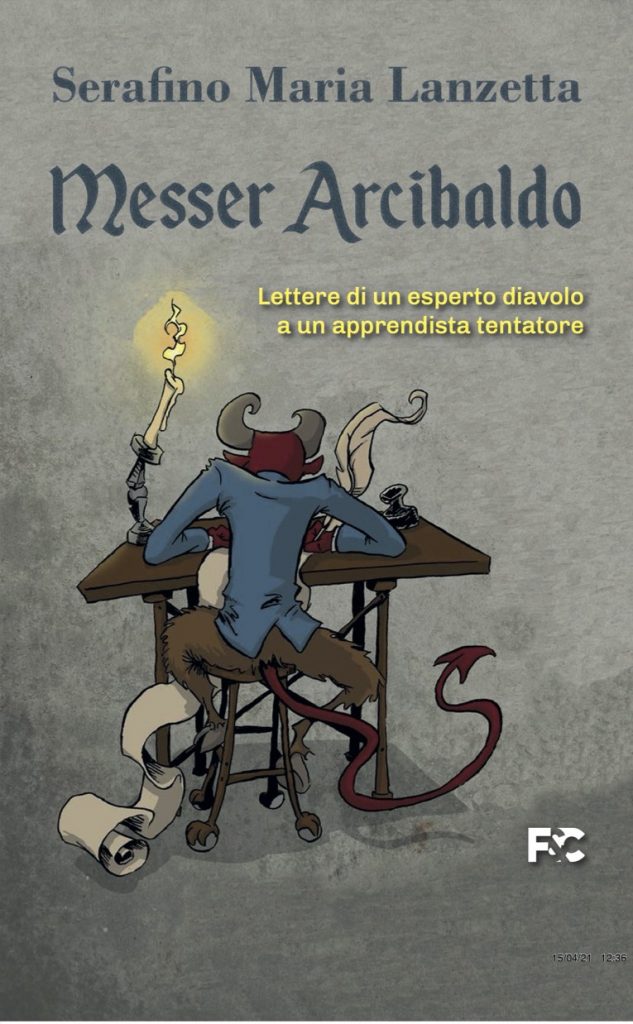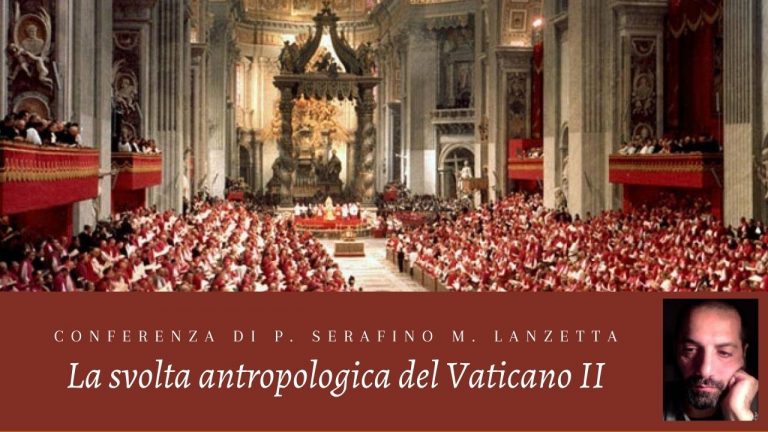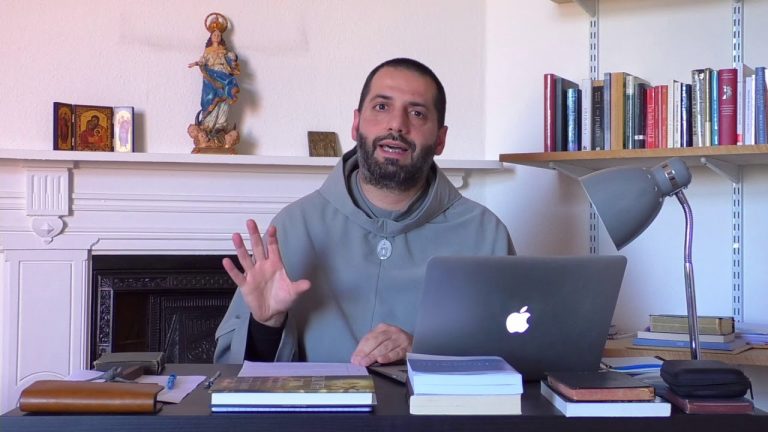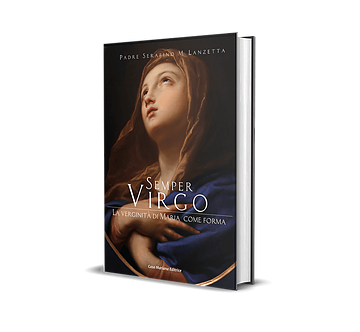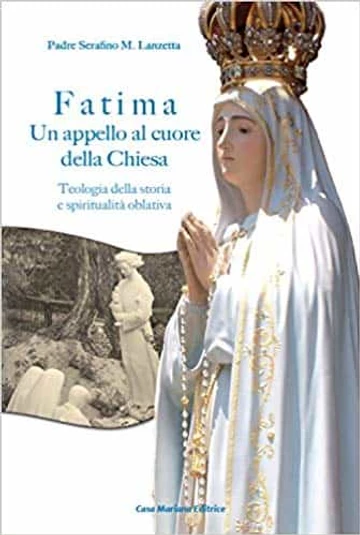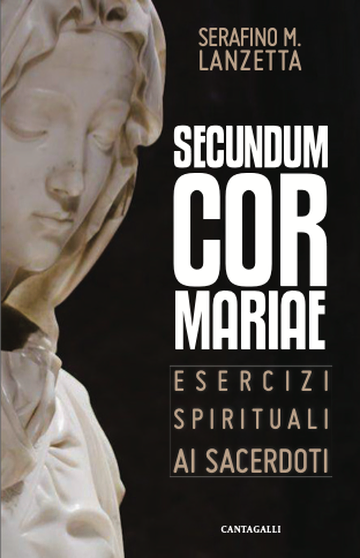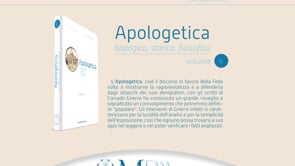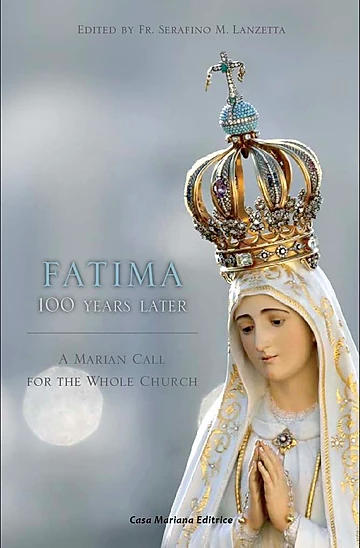By Karen Darantiere
The Door of Faith by Fr Serafino Lanzetta, a timely and timeless remedy to our Church’s woes
Having read Father Serafino Lanzetta’s new book, The Door of Faith, against the backdrop of Pope Francis’s recent words regarding the Communion of Saints, I cannot help penning my praise of this book without making reference to the pope’s troubling teaching. For the two are linked. One is a sign of the apostasy in which the Church is submerged, the other a diagnosis of our ailing faith as well as a remedy so it may shine anew in all its truth and beauty.
Unbelievably, the Holy Father actually uttered these words: “The communion of saints is precisely the Church… No one can exclude himself from the Church… those who have denied the faith, who are apostates, who are the persecutors of the Church, who have denied their baptism: are these also at home? Yes, even these, even the blasphemers, all of them. We are brothers: this is the communion of saints. The communion of saints holds together the community of believers on earth and in heaven… in Christ no one can ever truly separate us from those we love because the bond is an existential bond, a strong bond that is in our very nature… nothing and no one can break this bond.”
We might merely resort to sarcasm, derisively laughing: “Blessed be the blasphemers!” Or, we might pause to ponder over the fathomless falsehood of this catechesis. Without claiming to judge the heart of the pope, we can, nonetheless, express dismay when hearing words so shocking to pious ears and clearly contradicting Church teaching. Personally, my greatest dismay was caused by the resounding silence on the part of our shepherds, and, worse still, by favorable reviews published in reputedly reliable French Catholic journals, including one by a monk from a traditional monastery, who speaks in glowing terms while remaining silent on the shocking passage, and another whose title even dares to claim that this catechesis ‘sets the record straight’. Is not only faith but also reason in total eclipse?
Where are blasphemy and apostasy “at home” if not in the pits of hell from whence they come? What is this communion of saints if not the cacophony of the damned, where heaven becomes hell, good evil, and truth falsehood?One cannot help thinking of Bishop Fulton Sheen’s prescient warning in 1947 when, speaking of Satan’s perversely seductive logic, he stated: “…if there is no hell, then there is no sin; if there is no sin, then there is no judge, and if there is no judgement then evil is good and good is evil.” And he foresaw the setting up of a counter-Church “which will be the ape of the Church because, he the devil, is the ape of God. It will have all the notes and characteristics of the Church, but in reverse and emptied of its divine content. It will be a mystical body of the anti-Christ that will in all externals resemble the mystical body of Christ… the anti-Christ “will have one great secret which he will tell to no one: he will not believe in God. Because his religion will be brotherhood without the fatherhood of God…” Far be it from me to suggest that the Pope is the Antichrist or that the gates of hell will prevail against our Holy Mother Church! Undeniably, however, these words do ring somewhat true and should serve as a wake-up call to faithful Catholics.
Where are our shepherds warding off the wolves? If a well-catechized child can recognize this teaching for what it is, then what of our bishops? Have they utterly renounced their faith? Have they no care for their flock? Why have they fled, leaving us bereft of pastors? If apostates are part of the communion of saints, why believe? If nothing we do can separate us from the Church, why belong to it? Why profess our faith? Why receive the sacraments? Why pray? Why lead a moral life? Are apostates really part of “the community of believers”? What is believing if disbelief and belief are one and the same? What is faith? If the bond uniting us in the communion of saints is “an existential bond”, one belonging to “our very nature”, then what of grace? Is grace absorbed into nature, rendering it useless?
Happily, we find in Fr Serafino Lanzetta a faithful pastor, who has spoken with charity and clarity on this very topic. Thankfully, the answers to the above questions are found in The Door of Faith, hence its timeliness and timelessness.
“Faith is the door that opens the mystery of God to us and through which God gives us our raison d’être.” (XIII)
Providentially, The Door of Faith begins with the word ‘Faith’ and ends with the word ‘God’. Reading this book means embarking on a challenging and rewarding journey, the journey of faith to our final goal, God. But what is faith? We are confronted nowadays with diverging notions of faith, between which we must clearly distinguish, so as to choose the right door that will lead us in the right direction. The door of faith has as its threshold our ability to think rationally, to seek and find the truth: “it is essential to set out on a journey well-prepared… On must start at the foundation: reason.” (XIII)
The wrong door will lead us elsewhere, or rather nowhere: “a blind wandering around the streets of the world, believing that you can see something when in reality you only see darkness.” (XIII) This aimless wandering is caused by a rejection of reason, making of faith nothing more than an embrace of the irrational. However, “faith is real, not a mere ideal” (XIX), not a mere vain pursuit, but the embrace of the whole of reality, grounded in our natural capacity for reason and love, and granted through the supernatural gift of faith and charity. “Faith and charity work together like reason and love although the two pairs are on different levels… one natural and the other supernatural – in harmony, so that with reason and love, faith and charity, we can truly embrace the whole of reality and give a definitive response to our life.” (XIV) The problem we are confronted with in the Church, as in society at large, is a pitting of love against reason, charity against faith, whereas “reason and love cannot be set against each other, just as you cannot choose either faith or charity.” (XXIII)
The journey we embark on by reading this book is an ascent to ever-greater heights, starting with nature, elevated by grace, allowing us to see the face of truth and love incarnate in the Good Shepherd and to be nourished by this selfsame Logos-Love in the Holy Eucharist. Along the way, we perceive the natural to be in harmony with the supernatural, nature with grace, creation with redemption, the indissolubly wedded couple of reason-love in harmony with that of faith-charity. We understand faith as the divine seed growing into a tree whose roots in reason run deep and whose branches bear the beautiful fruit of charity. We see faith and charity not as opposing forces but as two wings of our Christian soul allowing us to soar heavenward. The whole is summed up in the paradigm: a love in truth for a truth of love, which becomes incarnate in the Word made flesh, in whom truth and life are one. We gaze upon the beautiful face of the Good Shepherd, whose eyes mirror a soul made of Love and Truth, who looks back upon his creatures made in His image, capable of knowing and loving in return He who knew and loved them first. We understand that his Body given for us in the Holy Eucharist is the truth of his self-giving love for humanity which nourishes us with Truth and Love throughout our journey until we reach our final destination in heaven.
Fr Lanzetta, while restoring to reason its natural dignity, also sheds light on the need to include the role of love in apologetic discourse. He firstly highlights the indissoluble knot uniting reason and faith, while warding off the danger to the faith caused by the loss of reason, before examining in depth the circular and harmonious relationship between reason and love, as the natural foundation on which rests supernatural faith and charity, all of this relying on his vast scholarship, particularly on the wisdom of Benedict XVI’s encyclical, Deus Caritas Est. At the start of the journey, we look through the false door, leading to the oblivion of faith, and peer down the path to a distant darkness, at an irrational landscape where truth is unknowable, where faith is a mere ideal without reality, where God is void of truth, that is, void of Himself.
What is the cause of the present oblivion of faith?
In response to this question we all wish to see answered, we learn that: “this crisis is generated largely by setting aside the question of God … When the thoughts of men and women are no longer capable of understanding God, they become non-thoughts and they head toward decline. Along with thought goes faith.”(p. 3). We grapple with nihilism, this logical haven of relativism, in which nothing is explained with God or without Him, where there is no true knowledge, nothing but radical agnosticism, and we see its two prevalent forms, one a nihilist-theist relativism, the other a nihilistic atheism, the former having seeped its poison rather deeply into the lifeblood of the Church, causing a fatal divide between faith and reason. God is no longer perceivable as the foundation of being, so faith is torn between the natural longing for goodness and the thought seeking for truth in vain. This skepticism, commonplace in society, has made its way into the minds of Catholics, who “due to systematic doubt must suspect the very principle of reasoning and therefore of faith,” to the point where many “see in Christ the teacher of a believing atheism and of a faith continually threatened by denial of God”(p. 22-23). However, “a philosophy or even a theology of doubt, which in the final analysis proves the possibility of being atheistic believers or believers continually threatened by atheism, is simply a rejection of thought.” (p. 33)
We have assimilated a weak idea of God, “in the image of a thought that has renounced being to focus on desire and then resigned itself to evil” (p. 84). We desire forgiveness but renounce truth, whereas “if mercy, as is sometimes hoped, cancelled justice, it would destroy itself; it would have no further raison d’être because there would no longer be any sin to pardon. The actions of men and women would be irrelevant, and God would simply be an empty and useless hope for forgiveness.” (p. 95) Ultimately, however, “the cancellation of God’s punishment following sin results sooner or later in ascribing the origin of the wound of human nature not to original sin [but] to God alone, … [so that] if we wanted God not to punish us, we would have paved the road to atheism.” (p. 104)
“Help me to see You with reason, to desire You with love, to believe with faith, to unite myself forever with You in charity.” (p. 36)
What is the solution to the problem? We must once again: “unite reason and love to know God. He is the fullness. He Himself is Reason and Love. The only true religion is the one where God is the fullness of reason and love, to which must correspond faith and charity.” (p. 7) Fr Lanzetta presents the beautiful teaching of William of Saint Thierry, a disciple of Saint Bernard’s, who identifies charity with the vision possessed by the soul to see God: “truth and charity are linked because one illuminates the other. They are so linked that charity itself, love in truth and the truth of love, has two eyes: reason and love,… which must not work separately, just as two eyes of natural sight: When one of them tries to see without the other it has little success, but when they work together they can achieve great things.” (p. 110-111)
We are led to see that the God of reason and the God of Revelation are one and the same: “In reality, the uncaused Cause, reason of everything including my own being, is a Person with an intellect and a will, with a heart. The God-cause is Reason and Love.” (p. 114) This pairing of reason and love is like the fertile ground in which a supernatural seed may be planted: “The pairing of reason-love… is the foundation on which another pairing rests: the union of faith and charity.” (p. 114) These theological virtues enable us to know and unite with God: “Faith purifies in order to ‘see’ God, charity is the possession of God, namely, being in Him. Faith and charity find their unity in the mystery of God believed and loved.” (p. 117)
“Will there be a living Jesus opposed to the faith which He Himself taught? (p. 77)
The divorce between reason and love has engendered an unnatural divide between faith and charity. What is faith? “To believe is to welcome God’s Revelation, namely the truth introduced by God for my salvation. To believe is an act of obedience to God, moved by His Grace … There is not, nor should there be, a divide between faith understood as concepts to learn and faith lived in a personal encounter with the Lord… We must recover… the harmonious relationship between the two … Faith, in fact, is an intellectual and loving assent to supernatural truth…” (p. 23-24) In reality, in Christ we see the unity between the noetic and dynamic aspects of the Word, through Him we can see that assent to revealed truth is not opposed to a loving encounter. (p. 62)
The false dichotomy between faith as an encounter with Christ and faith as the loving assent to His truth has resulted in such ambiguous proclamations as that of the Synod of Bishops (May 2012) on the transmission of the faith: “…referring to the Gospel, we must not think of it only as a book or a set of teachings…. It is not so much a system of articles of faith and moral precepts… but a person: Jesus Christ…” (p. 77) How tiresome are such semi-negations which, without outright denying that the Gospel contains doctrine, hint that what truly counts is a person who apparently has little concern for faith or morals, as if in Christ truth and life were not one! In reality, “the two aspects are mutually implicit, so the dynamism would be empty without a content to be realized” (p. 77) There can be “no catechesis which rejects the truths of faith, or the transmission of concepts and dogma which those truths express, to make room solely for a living encounter with Christ, for an experience of the Risen One.” (p. 77)
“To set aside doctrine to make room for pastoral care is not only contradictory, but hides an explicit rejection of Christ.” (p. 129)
The unnatural divide between truth and love, faith and charity, has given rise to a false division between doctrinal teaching and pastoral care: If pastoral is conceived as opposed to doctrinal, “we would also have eliminated its meaning of love, which begins from truth and bestows truth.” (p. 126) However, doctrinal truth is in harmony with pastoral care, as faith, once assented to, can be acted upon. “ Doctrine is the faith of the Church… understood and believed… while pastoral care is charity which sees and realizes the believed doctrinal principles, transforming them into food for the faithful. Thus, faith becomes operational.” (p. 124) There is an “intimate relationship between doctrine and life, teaching and salvation.” (p. 124) Ultimately, “to set aside doctrine to make room for pastoral care is not only contradictory, but hides an explicit rejection of Christ.” (p. 129) On the contrary, pastors must base their care of their flock on the familial relationship between the Good Shepherd who knows his flock and whose flock knows Him: “This knowledge is therefore an intimate, intellectual, and affective relationship between the Shepherd and His sheep… At the center of this life-giving relationship… is the eternal Logos become the Good Shepherd in His incarnation, which has its salvific fulfilment in redemption through His death on the Cross… Contained in the Eucharist is the food for the sheep, which is doctrine and life, truth and love, tied together for ever in the unique person of the Savior Word..” (p. 127-128)
“Drawing close to Christ, in the beauty of His gaze, we are enchanted by the goodness of truth and by the truth of goodness” (p. 203)
Truth and love unite in one mystery: the Word incarnate, the Good Shepherd, the incarnate Logos-Agape: “In God reason and love are one. In Christ reason and love become flesh. In Him, the Good Shepherd, as in a magnificent canvas, the Logos and Agape, reason and charity, harmonize in the perceptibility of the flesh… In Him, man, who was made in His image and likeness, is reborn in the truth of the unity of reason and love, a reason which is the foundation of love and a love which is the fullness of reason. What is more, in the incarnate God, Logos and Agape are united in a harmony which unifies everything: beauty… The face of the Good Shepherd is the face of beauty… Drawing close to Christ, in the beauty of His gaze, we are enchanted by the goodness of truth and by the truth of goodness…” (p. 202-203)
Gazing at the Good Shepherd can allow us to disentangle ourselves from the post-modern thought incapable not only of truth, but also of beauty, as, deprived of truth, “the aesthetic perception, too, is nihilistic.” (p. 173) Contemplating the beauty of His face, humanity can embrace true love and regain “its thought of love (agape) and of its love of thought (logos).” (p. 203) This same Good Shepherd nourishes us with his truth and love in the Holy Eucharist: “With the Eucharistic mystery, the discourse about a personal circularity of truth and love is brought to completion.” (p. 208) In a word, “the Eucharist is the truth of God who is love, and in the Eucharist is the gift of the truth of love.”” (p. 210-211)
“Why not begin with love to tell men and women, who only want to hear about love, that the truth about themselves, about reality, about God, is realized precisely in love?” (p. 134)
Humanity today is inebriated with a false idea of love: “the word of the day is love, but its true meaning is euphoric and undisciplined eros.” (p. 227) This love, so often claimed as our unique good, as it is deprived of truth, has become its contrary, to the point of defending abortion and euthanasia. Hence the need to engage in “the defense of love, the restoration of its true face … [as] to be and to love are one in God” (p. 130). With this in mind, Fr Lanzetta invites us to renew with apologetic discourse as a “proposal of the truth of love, for a love in truth and a love of the Truth.” (p. 131) This harmonious pairing of truth and love necessitates speaking of love in truth: “It is necessary to denounce error to love the errant, without pretending to love them by keeping silent about the truth and thus choosing falsehood. Silence is kept in the belief that one is loving, but instead the other person is offended because they are being offered falsehood. The first and greatest charity is to give the truth.” (p. 145)
This renewal of apologetic discourse, based upon the circularity of truth and love, will restore our vision, enabling us to see Christ truly and, in His eyes, to see our true selves, for “truth and love coincide in Christ.… Love without truth would be blind” (p. 152) In this case, “humanity would believe in a non-living God, and religion would deteriorate into praying to a God it does not know.” (p. 159) Unveiled before our mind’s eye is a false discord between Christ’s human and divine natures, whereas we must perceive once again his Life as one with his Word: “the eternal Logos… without any division or confusion is Truth and Charity.” (p. 129) We will thus be able to encounter Christ, holding fast to His truth and uniting in his Love, healing thereby the false division posited within our own souls between knowing and loving. The correct perception of the circularity of truth and love will restore full rights to the love of the truth about God and humanity, to “a love of the logos, to finally find the logos of love.” (p. 161) This will lead to a sapiential love where“God and humanity meet in reason and in love… [in] the unity of nature with grace, of reason-love with faith.” (p. 161)
Moreover, we will perceive God truthfully in his Trinitarian Being, and ourselves as His mirror image in our capacity for loving and truthful communion: “In God there is the inter-twining of truth and love. Truth, being One, is the foundation of the love of the being Three, and being Three is the perfection of being One. In God love remains in truth, and His truth is love: the Trinity in Unity and Unity in the Trinity. Every multiple needs to become one, and every unity is fulfilled in multiplicity. Therefore, you cannot simply get rid of metaphysics without getting rid of God, of His being in love, and in the end getting rid of humanity, or being man.” (p. 151)
“Humanity will be capable of looking at reality with real eyes, with the truth of love, with the Logos of Love, through Mary, the handmaid of the Lord.” (p. 194)
Perceiving once again the natural and indissoluble bond between truth and love will restore God to humanity and humanity to itself, for: “reason and love either go hand in hand or both fail. The paradigm of reason and love becomes personal in Christ. Truth and love meet definitively in the Person of the Word incarnate, in whom we share by faith and charity, and of whom we are partakers in the mystery of the Holy Eucharist. Truth and love are one Person, Christ… By correctly coordinating the relationship between reason and love, we can indeed address the whole of reality: all that is thinkable and an object of love. This is why reason and love together can do great things, especially in restoring to a post-Christian society the possibility of addressing the core of all problems: God.” (p. 239-240)
By way of conclusion, it is appropriate to end with these words of Fr Lanzetta who, true to his Marian Franciscan heart, cannot help but present to us the Virgin Mary as the golden standard of the indissoluble harmonious pairing of reason and love, on the one hand, and faith and charity, on the other: “Is it not perhaps because we have got rid of the Madonna – minimizing, redefining, whittling away here and there at her unique presence in the mystery of Christ and the Church – that faith has got rid of an important ally such as reason? The Virgin is a sign of the truth which opens itself to faith, of the reason which seeks to understand with the Logos of God… The Virgin gives us Christ, the Logos of incarnate love which gives to humanity the true face of God: the face of Being always identical in an infinite love… Humanity will be capable of looking at reality with real eyes, with the truth of love, with the Logos of Love, through Mary, the handmaid of the Lord.” (p. 194)

